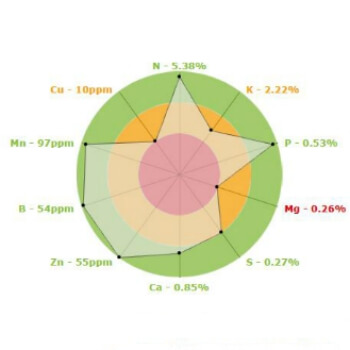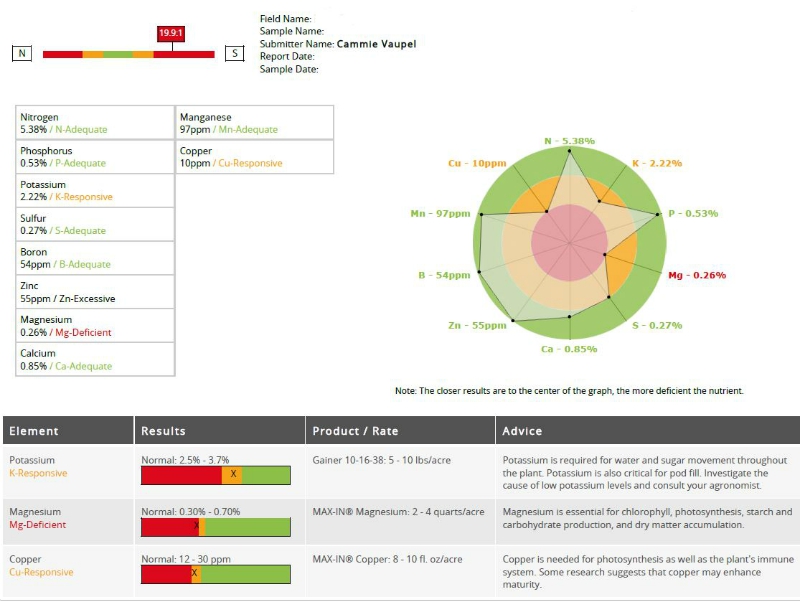Wheat Topdress in Spring
Feb 26, 2019

Although winter seems to want to hang on, it will soon be time to get your topdressing done on your wheat. How do we know how much to apply to give your wheat enough food to prosper this spring and make the most possible bushels? Below are a few options to consider:
Utilize soil tests: Those fields that were soil tested in the fall will have a base for applying the remaining fertilizer. Using university guidelines, subtract what you applied in the fall from the needed nitrogen to get an idea of what the plant will need. However, consider the fact that we had heavy moisture events in the fall and that some of your Nitrogen may have leached down below the root level of our smaller than normal wheat. If you used a stabilizer, this will be less of a concern.
Tissue Testing: Another option for applying optimum nitrogen and other nutrients is to have a tissue test pulled. The tissue test analysis will give you the current levels of nutrients in the plant at the time of sampling. These results, along with your crop adviser, can help you understand what exactly the plant needs to finish out the season. This is a good way to tell if you have leached some nitrogen as well, if you think that you applied plenty in the fall but the plant is lacking. Tissue testing can be done through the Great Bend Co-op. See below for an example of a report from a tissue test through NutriSolutions®
Satellite Imagery and Variable Rate Application: In-Season satellite imagery is available on many of the fields in our area through the R7 Tool® by WinField United®. These images can be used to determine the variability of your stand within the field. This can be combined with the other tools to locate areas of concern for scouting and/or tissue testing. Using satellite imagery, soil tests, and/or tissue testing, the field can then be split into zones for Variable Rate Application of your spring topdress. This option allows you to place the fertilizer where you will get the best Return on Investment.
No matter which option you choose, topdressing wheat is key to getting the most out of your wheat crop. As soon as the weather allows, we will be hit hard with acres to cover. Make arrangements to meet with your Great Bend Co-op Agronomy Sales Staff as soon as possible to get your acres turned in.
Tissue Test Result Example:

Utilize soil tests: Those fields that were soil tested in the fall will have a base for applying the remaining fertilizer. Using university guidelines, subtract what you applied in the fall from the needed nitrogen to get an idea of what the plant will need. However, consider the fact that we had heavy moisture events in the fall and that some of your Nitrogen may have leached down below the root level of our smaller than normal wheat. If you used a stabilizer, this will be less of a concern.
Tissue Testing: Another option for applying optimum nitrogen and other nutrients is to have a tissue test pulled. The tissue test analysis will give you the current levels of nutrients in the plant at the time of sampling. These results, along with your crop adviser, can help you understand what exactly the plant needs to finish out the season. This is a good way to tell if you have leached some nitrogen as well, if you think that you applied plenty in the fall but the plant is lacking. Tissue testing can be done through the Great Bend Co-op. See below for an example of a report from a tissue test through NutriSolutions®
Satellite Imagery and Variable Rate Application: In-Season satellite imagery is available on many of the fields in our area through the R7 Tool® by WinField United®. These images can be used to determine the variability of your stand within the field. This can be combined with the other tools to locate areas of concern for scouting and/or tissue testing. Using satellite imagery, soil tests, and/or tissue testing, the field can then be split into zones for Variable Rate Application of your spring topdress. This option allows you to place the fertilizer where you will get the best Return on Investment.
No matter which option you choose, topdressing wheat is key to getting the most out of your wheat crop. As soon as the weather allows, we will be hit hard with acres to cover. Make arrangements to meet with your Great Bend Co-op Agronomy Sales Staff as soon as possible to get your acres turned in.
Tissue Test Result Example:
